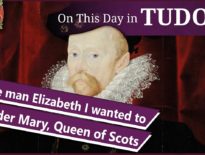On this day in history, 27th September 1442, in the reign of King Henry VI, John de la Pole, 2nd Duke of Suffolk, was born.
He may have been born in the Plantagenet period, but Suffolk's first wife was Lady Margaret Beaufort, the future mother of Henry VII. Suffolk went on to serve Henry VII loyally, although his son was involved in the Lambert Simnel Rebellion.
Find out more about John de la Pole, 2nd Duke of Suffolk, his life and career, and what happened with his marriage to Lady Margaret Beaufort, in today's talk.
Also on this day in Tudor history, 27th September 1501, Catherine of Aragon, daughter of Ferdinand II of Aragon and Isabella I of Castile, set sail for England from Laredo, Spain.
Catherine was leaving her homeland to marry Arthur Tudor, son and heir of King Henry VII, a marriage arranged by her parents and the English king in the Treaty of Medina del Campo.
This was Catherine's second attempt at sailing to England, but this time she was successful. Find out more in last year's video:
Also on this day in history:
- 1488 – Death of William Hobbes, physician and surgeon. He was buried in Holy Trinity Priory, Aldgate, London. Hobbes served Richard, Duke of York, and Edward IV, and was Royal Physician to Richard III. He became Master of St Mary of Bethlehem Hospital (Bedlam) in 1479.
- 1540 – Birth of Michael Heneage, politician and antiquary. Heneage was a member of Parliament, a Keeper of the Records in the Tower of London, and a member of the Society of Antiquaries.
- 1571 – Death of Sir William Garrard, merchant, in London. He was buried in the church of St Magnus the Martyr near London Bridge. Garrard was Mayor of London in 1555, and a member of Parliament during Mary I's reign. He also went on voyages to Guinea in the 1550s and 1560s, and became a consul of the Russia Company in 1553.
Transcript:
On this day in history, 27th September 1442, in the reign of King Henry VI, John de la Pole, 2nd Duke of Suffolk, was born.
Why am I talking about a man born in the Plantagenet period, you may wonder? Well, he had plenty to do with the Tudor dynasty.
Let me give you some facts about him.
• He was the son of William de la Pole, 1st Duke of Suffolk, and his wife Alice Chaucer.
• In 1449, when he was just a small boy, John married his distant cousin, Margaret Beaufort, who was, of course, the future mother of King Henry VII.
• John’s father, William, was for a time the main power behind King Henry VI but was brought down by his enemies and impeached by the Commons. Henry VI intervened, sending the duke into exile, but his ship was intercepted and he was given a mock trial and beheaded. John inherited his title, but his father’s offices were taken by the Crown and John became a ward of the Crown.
• In 1453, John’s marriage to Margaret Beaufort was annulled by King Henry VI who made Margaret a ward of his half-brother, Edmund Tudor, who she married in 1455.
• In 1458, John married Elizabeth, daughter of Richard of York and Cecily Neville, and sister of the future Edward IV and Richard III. This obviously allied John with the Yorkists and he ended up being degraded from Duke of Suffolk to Earl of Suffolk in 1459 when the Duke of York was attainted and driven into exile.
• John fought on the Yorkist side at the Battles of St Albans and Towton in 1461 and acted as steward of England at his brother-in-law Edward IV’s coronation.
• In 1463, a few months before he reached maturity, he came into his lands, and in 465 he was granted an annuity by the king. In 1467 his eldest son, also called John, was made Earl of Lincoln.
• John fought on Edward IV’s side at the Battles of Barnet and Tewkesbury in 1471 and his rewards included being made high steward of Oxford University, a Knight of the Garter, and Lieutenant of Ireland.
• In 1475, he served Edward IV in France, and in 1476 his mother, Alice, died, and he took possession of some of her dower estates.
• King Edward IV died suddenly in 1483 and John carried the royal sceptre at Richard III’s coronation after Edward V had been ruled illegitimate. Following Richard’s son’s death, John’s son, the Earl of Lincoln, was made President of the Council of the North in his place, and may even have been considered Richard’s heir. However, John lost his office of Constable of Wallingford to Francis, Viscount Lovell.
• In 1485, Henry Tudor, son of Lady Margaret Beaufort, returned from exile and fought King Richard III at the Battle of Bosworth. John didn’t fight at the battle, but his son, Lincoln, fought on Richard’s side. Richard was killed and Henry became King Henry VII. John and his son did not suffer for their links with Richard, and John was even reappointed as Constable of Wallingford, in place of Lovell who was attainted after Bosworth. John acted as a trier at the new king’s first parliament but in 1487 his son, Lincoln, rebelled against Henry VII, supporting pretender Lambert Simnel who claimed to be Edward, Earl of Warwick. Lincoln was subsequently killed at the Battle of Stoke Field. Fortunately for John, he managed to keep the trust of the king, acting as trier at the next Parliament and mustering for the king’s expedition to Brittany. He did lose his Wallingford office though.
• John died in May 1492 and was buried in the college he’d founded at Wingfield in Suffolk



Some authors believe that Margaret and William were not married but betrothed but if she was contracted as being an unbreakable match it was as if they were married. Just think Henry Vii might have been a de la Pole rather than a Tudor.
Alice Chaucer was showing some common sense here because she was a supporter of the Lancaster House as her family had taken them as the current Kings but now Alice affiliated herself and her family with the rising House of York by marrying her son, John to Elizabeth, sister of Edward iv. John de la Pole was loyal to them but conformed to Henry Tudor. His son, another John was as you say in with Richard of Gloucester, Richard iii and may have been made his heir. This is not certain and the sources don’t make it implicit. However, John, now Earl of Lincoln raised the whole Edward of Warwick /Lambert Simnel scenario and was killed at East Stoke in 1487, supporting the House of York again.
Simnel was probably a cover for his own claim.
I am off to Piel Island tomorrow where Lambert Simnel, the Dublin King landed with his army from Ireland.